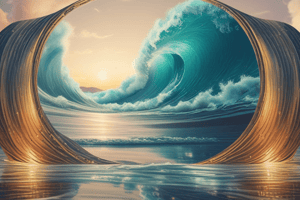Podcast
Questions and Answers
What type of image is formed by a plane mirror?
What type of image is formed by a plane mirror?
- Virtual (correct)
- Real
- Reversed
- Inverted
What is the relationship between the angle of incidence and the angle of reflection in a plane mirror?
What is the relationship between the angle of incidence and the angle of reflection in a plane mirror?
- The angle of incidence is less than the angle of reflection
- The angle of incidence is greater than the angle of reflection
- The angle of incidence has no relation to the angle of reflection
- The angle of incidence is equal to the angle of reflection (correct)
What is the focal length of a plane mirror?
What is the focal length of a plane mirror?
- Infinite (correct)
- Negative
- Finite
- Zero
What is a characteristic of the image formed by a plane mirror?
What is a characteristic of the image formed by a plane mirror?
What is a common use of plane mirrors?
What is a common use of plane mirrors?
What is the orientation of the image formed by a plane mirror?
What is the orientation of the image formed by a plane mirror?
What happens to the intensity and wavelength of light when it falls on a plane mirror?
What happens to the intensity and wavelength of light when it falls on a plane mirror?
What is the relationship between the incident ray, reflected ray, and normal to the mirror surface?
What is the relationship between the incident ray, reflected ray, and normal to the mirror surface?
What is the distance between the object and the virtual image formed by a plane mirror?
What is the distance between the object and the virtual image formed by a plane mirror?
What is a common application of plane mirrors in optical instruments?
What is a common application of plane mirrors in optical instruments?
What does a plane mirror do to the shape or size of an object?
What does a plane mirror do to the shape or size of an object?
What is the effect of a plane mirror on the orientation of an object?
What is the effect of a plane mirror on the orientation of an object?
Flashcards are hidden until you start studying
Study Notes
Characteristics of Plane Mirrors
- Reflection: Plane mirrors reflect light and images, but do not change the orientation or size of the image.
- Virtual image: The image formed by a plane mirror is virtual, meaning it appears to be behind the mirror.
- Reversal: Plane mirrors reverse the image, but do not invert it.
Laws of Reflection
- Angle of incidence: The angle at which light hits the mirror.
- Angle of reflection: The angle at which light bounces back from the mirror.
- Law of reflection: The angle of incidence is equal to the angle of reflection.
Image Formation
- Object distance: The distance between the object and the mirror.
- Image distance: The distance between the image and the mirror.
- Mirror equation: 1/o + 1/i = 1/f, where o is the object distance, i is the image distance, and f is the focal length (which is infinite for a plane mirror).
Properties of Image Formed
- Size: The size of the image is equal to the size of the object.
- Orientation: The orientation of the image is reversed, but not inverted.
- Laterally inverted: The image is laterally inverted, meaning left and right are swapped.
Uses of Plane Mirrors
- Optical instruments: Plane mirrors are used in telescopes, periscopes, and other optical instruments.
- Decorative purposes: Plane mirrors are used for decorative purposes, such as in mirrors and reflective surfaces.
- Scientific applications: Plane mirrors are used in scientific applications, such as in laser systems and spectroscopy.
Characteristics of Plane Mirrors
- Plane mirrors reflect light and images without changing their orientation or size.
- The image formed by a plane mirror is virtual, appearing behind the mirror.
- Plane mirrors reverse the image, but do not invert it.
Laws of Reflection
- The angle at which light hits a mirror is the angle of incidence.
- The angle at which light bounces back from a mirror is the angle of reflection.
- The law of reflection states that the angle of incidence is equal to the angle of reflection.
Image Formation
- The distance between an object and a mirror is the object distance.
- The distance between an image and a mirror is the image distance.
- The mirror equation is 1/o + 1/i = 1/f, where o is the object distance, i is the image distance, and f is the focal length (infinite for a plane mirror).
Properties of Image Formed
- The size of the image is equal to the size of the object.
- The orientation of the image is reversed, but not inverted.
- The image is laterally inverted, meaning left and right are swapped.
Uses of Plane Mirrors
- Plane mirrors are used in optical instruments, such as telescopes and periscopes.
- Plane mirrors are used for decorative purposes, like mirrors and reflective surfaces.
- Plane mirrors have scientific applications, such as in laser systems and spectroscopy.
Reflection of Light
- Light that falls on a plane mirror is reflected back with the same intensity and wavelength, preserving its original properties.
- The law of reflection is in effect, where the angle of incidence equals the angle of reflection.
- The incident ray, reflected ray, and normal to the mirror surface all lie in the same plane, ensuring a precise reflection.
Image Formation
- A plane mirror produces a virtual image that is upright and identical in size to the object, providing an accurate representation.
- The image is formed behind the mirror, at a distance equal to the object's distance from the mirror, creating a sense of symmetry.
- The image undergoes lateral inversion, resulting in a mirrored reflection where left and right are reversed.
Characteristics of Plane Mirrors
- Plane mirrors do not alter the shape or size of the object being reflected, preserving its original dimensions.
- The mirror maintains the object's original orientation, ensuring the image is faithful to the object.
- The distance between the object and the observer remains unchanged, providing an unobstructed view.
Applications of Plane Mirrors
- Plane mirrors are utilized in optical instruments, such as telescopes and microscopes, to enhance visibility and precision.
- Periscopes employ plane mirrors to redirect light, allowing for indirect viewing.
- Laser systems rely on plane mirrors to redirect and manipulate light beams with precision.
- Everyday applications of plane mirrors include dressing mirrors and rearview mirrors, serving practical purposes.
Studying That Suits You
Use AI to generate personalized quizzes and flashcards to suit your learning preferences.




